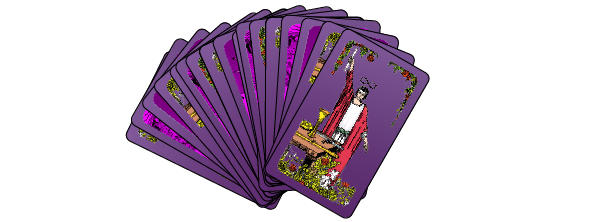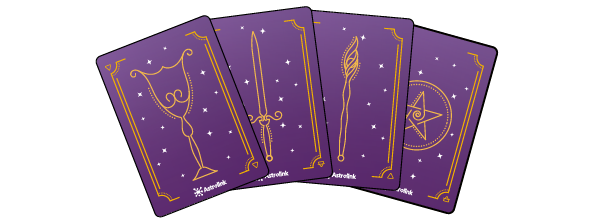Tarot
The oracle of our unconscious

Tarot is generally associated with fortune tellers, esoteric, magical, ancestral things or something far removed from rationality and traditional science.
The fact is that all its symbolism is closer to our daily lives than we realize. Many important personalities have realized this fact at different times, assimilating and passing on all the knowledge that this oracle can provide.
Carl Gustav Jung, famous psychotherapist who founded analytical psychology was one of these people. Jung studied many concepts and coined many terms that are widely known today, such as extroversion, introversion, archetypes, unconscious, shadow, complex, synchronicity among others. He describes the Tarot symbols as archetypes of the collective unconscious, that is, everything that inhabits the deepest part of our being.
We must see Tarot as a tool to unveil our unconscious, which allows us to analyze and interact with our rich inner world. In tarot cards, we can project our feelings and thoughts, better understanding what surrounds us and our role at the moment. Tarot invites us to learn more about ourselves and live in alignment with the powerful forces of the universe.
Major Arcana (22) More details
The Major Arcana represent man's journey of evolution told through ancestral symbols. The meanings of these cards illustrate the structure of human consciousness, containing deeply meaningful life lessons passed down from generation to generation.
Minor Arcana (56) More details
While the Major Arcana represent the higher directives - the divine providences that we can hardly escape, the Minor Arcana act within the field of our free will, our choices and attitudes, as well as the role and influence of other people in relation to our lives.
What is the Tarot?
The Tarot is a guide, a mirror that reflects the entire spectrum of human experience through archetypes. Because it was used over the centuries basically as an instrument of divination (where its meanings for this purpose are derived from Kabbalah, the mystical aspect of Judaism and also from medieval alchemy), it gradually lost its characteristics originals.
To recover all its symbolism and understand its potential, we must go back in time in search of several of our most important cultural heritages, when the Tarot was seen as a source of wisdom and understanding of the heart and mind and not just as a crystal ball.
Yes, the Tarot is something ancient based on other divinatory systems. Many people think that its total creation is unique and dates back to the Middle Ages, but its references are much older, including Egyptian and ancient Greek values. As for the Egyptians, instead of cards, they used amulets, tokens and boards as divinatory systems.
As a system of occult meaning and esoteric orientation, Tarot was limited to remaining hidden and marginalized in medieval Europe. Disguising Tarot as a game was one way to allow practitioners to continue their use without being persecuted by the church. Our traditional deck, which we use in our games and fun times, is actually a simpler derivation of the Tarot. Genius, right? Who could have imagined at the time that a simple deck of cards was actually an oracle that brought together the entire journey of human experience...
At one point, the Tarot was called the "Devil's Picture Book" by the Catholic church, where many heretics who used it were killed during the inquisition. This is why many records of its history are chronologically irregular. Historically, the Tarot seems to resurface in records only at certain times. Those who knew it always used it, but only secretly and when they really needed it.
It is perfectly understandable that people who have never had contact Tarot think things like: "But they are just cards and images! How can this say anything about my life?" or even more directly: "I don't believe any of that nonsense!".
Know that there is no problem with these or similar opinions. But, as with astrology, it is very important to give your final verdict on the subject only after breaking through the veil of shallow opinions and delving a little deeper into the subject.
Therefore, this area is an invitation to reflect on and experiment with this rich tool for self-knowledge.
The use of Tarot as an Oracle
Oracles were the first links between human beings and deities. The Tarot is one of the artifacts that plays this role, of bringing us closer to that something superior, transcendent, hidden. Its study represents a journey of inner discovery, where we come to know ourselves better so that we can act in accordance with our true essence.
It's a tool that contains symbols that hold the secrets of the Universe in their foundations, giving us the opportunity to unravel them in order to obtain various answers.
The Tarot is not deterministic nor does it influence the course of events, it only indicates the circumstances present at the moment and the energies involved in their development, i.e. those with the greatest potential for happening. The Tarot is not deterministic nor does it influence the course of events.
Know that Tarot is something naturally related to astrology, where there is an alchemical correspondence, an astrological sign and a number for each archetype. The 78 cards can be considered a journey, which helps to open doors that improve our understanding of the past and present, enabling us to sharpen our perception of the future. It is a tool that inspires us to better understand what we can accomplish and our role as protagonists in our lives.
The Arcana of the Tarot
The word "Arcane" basically means "secret, hidden, mystery". In them we find the mysteries of human nature, the answers to all our human questions.
In the Tarot, there are two groups of cards: the Minor Arcana, which total 56 cards (14 of each suit) and the Major Arcana, which total22 cards. The complete deck then has 78 different cards.
It is very important to take into account both the Major Arcana and the Minor Arcana in a Tarot consultation, as this way we can know all of them. potential people involved in the situation in question.
From the spontaneity of the card The Fool to the maturity of the card The World, the Tarot communicates through a symbolic language in a deck composed of 78 cards, where 22 are called Major Arcana and the other 56 of Minor Arcana, these, with four distinct suits : Pentacles, Swords, Cups e Wands.
Digging deeper into the information...
The symbols used in Tarot are deeply rooted in history and mythology. These are models inherited from our ancestors, which influence the way we interpret things. The Tarot allows us to put them together in various configurations to tell and interpret different stories. In this way, we can draw parallels between the meanings of the cards and our own experiences.
The story we tell about ourselves and the vision we have of our own existence greatly influences the way we think about our future. Tarot cards help us tell this story, specifically revealing facets that we sometimes don't realize about a question or the current moment in our lives. When we study each Arcanum, we can analyze our attitudes, our way of being or how we are positioning ourselves in relation to something.
An interesting way to understand Tarot is to see it as a tool to unveil our unconscious and express externally what is happening inside us. In the cards, we can project our feelings and thoughts, better understanding what surrounds us and our role in the current moment. Tarot invites us to learn more about ourselves and write our stories in alignment with the invisible and powerful forces of the universe.
How to read the Tarot correctly?
Ideally, consultations should always take place in a quiet, clean and pleasant place, preferably without outside interference or without being interrupted by anything. Always turn off unnecessary appliances as well as any objects that make a lot of noise - especially dissonant ones.
If you're going to use a physical deck, it's always a good idea to keep it wrapped in a clean white cloth or in a box of your own, in a place that only you can touch. For virtual consultations, follow the same instructions and try not to divert your attention to other stimuli. Just concentrate on what you're trying to do.
Mentalize an important question in your life for a few moments. It could be a specific question, a tip on how to behave in a situation or just a direction for your current moment. Direct all your intentions towards an appropriate response. Do this for as long as you feel appropriate. Then carry on with your consultation to see a card that resonates with your mindset.
The message contained in the letter - or in the letters withdrawn is for you - and you alone. It is the most suitable response for your current moment or the situation in your mind. A new consultation, especially on the same subject, should not be repeated until there has been reflection and understanding of what has been conveyed.
The Tarot is a subjective tool that should be used with tranquility, awareness, responsibility and only in moments where you feel you must make a personal connection with the powerful forces that govern the causality of the universe. Such an action may bring revelations that may or may not influence the timeline of your life, so reflect on what was transmitted to you intuitively and at the same time consciously.
Before starting the consultation, concentrate, meditate and ask your spiritual guides for protection and inspiration. After that, ask the question you want to find answers to. You can ask it out loud or do it mentally, focusing completely on the question. The most important thing is that your question or mentalization is very clear, direct and objective.
After your moment of concentration, when you feel the time has come, get your revelation.





 © 2012 - 2025. All rights reserved.
© 2012 - 2025. All rights reserved.